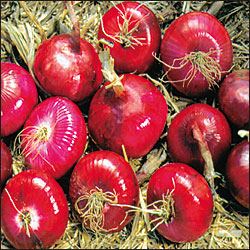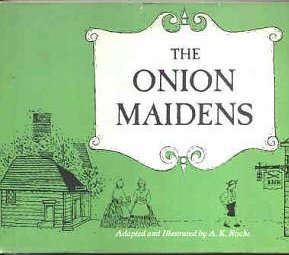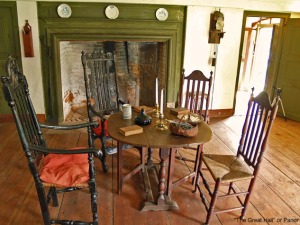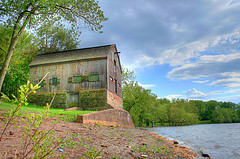In those days, you could smell Wethersfield before you could see it. Outsiders dubbed the Connecticut village “Oniontown”, with a crosshatch of affection and derision, for this was home of the world-famous Wethersfield red onion, and its pungent scent stung the air. Wethersfield lies in the heart of the Connecticut River valley, and her floodplains released an exuberant harvest.
Today the town is a suburb, though some vestiges of its gloriously arable past survive. But it’s not the way it was. Just imagine the fields back then: ruddy with onions, sky-blue with flax, puckered with all manner of vegetable and grain and leaf.
Local seed companies would sprout in later years, and in fact, for a time Wethersfield was a veritable headquarters for the young country’s sowers. This seems perfectly logical when you consider what a lush wedge of exploitable geography lies here. Indeed, bone up on a little local history, and you’ll find a parade of citizens referred to deadpan as “a pioneer in lima beans” or “the horseradish king.”
But it was the eponymous onion that got the most attention. Those old Wethersfield reds were lovely to look at. Like Christmas ornaments they were, all round and blushing and braided into skeins, sometimes five pounds’ worth, dangling from the rafters and doorways. At the Wethersfield Historical Society, onion designs spangle canvas tote bags and stationery and handkerchiefs, but the Wethersfield red doesn’t much dot the actual landscape now — a Civil War-era blight known as pinkroot conspired to end its two-century reign.
But before the blight, a whole world sprang up around them. Poultices were made from their translucent saute — indeed the heroine of The Witch of Blackbird Pond, a beloved children’s book set in Wethersfield, has her life saved by one steaming application. The local Congregational church is even known as “the church that onions built,” since it paid its town taxes in reds rather than greenbacks for many years.

Casting for the Witch of Blackbird PondBut the most notable bit of onion lore comes from the “onion maidens,” as the girls who harvested the reds were called. It was said the girls “weeded and wept,” reaping the onions for the reward of a silk dress, although Nora Howard of the Historical Society casts a somewhat gimlet eye on this bit of myth making.
“An English traveler wrote a book in 1780 that painted the Wethersfield onion girls as frivolous young things who would dirty their fingernails to get silk dresses,” she says. “It turns out he was driven out of Connecticut because of his Tory sympathies and wrote the book as a kind of revenge. Besides, there was about enough silk going around in those days to make a handkerchief. Instead, we’ve found out, the girls used their onion money to buy things like chewing tobacco and snuff!”
The people of Wethersfield were quite proud of the onion maidens. Their roll-up-your-sleeves attitude also carried over into the culinary realm: It was said that any old cut of meat tasted better in Wethersfield because it was stewed and spiced with the local onions.
Wethersfield has a pleasantly roguish past, much less pious than the Puritan settlements over in Massachusetts Bay. Its founder was John Oldham, kicked out of Plymouth for pulling a knife on Miles Standish. (Standish had asked Oldham to take his turn at doing the duty of “watch and ward” and apparently Oldham wasn’t in the mood just then.)
Oldham took off west with a group of men, mostly from Watertown, Massachusetts, known to history by the dashing name of “The Ten Adventurers.” By the time Oldham reached Wethersfield in 1633, he had mended his nasty ways. The story goes that Oldham nearly drowned, vowing to God that if He kept him afloat he’d “become otherwise and like ye.”
Perhaps our reformed knifer became a bit more “otherwise,” but he — and the town he founded — generally discarded the religious life for the commercial. And who could blame them? The rich river soil was some of the best in the world, deep, well drained, piling up for a millennium under the prehistoric lake that once lapped above it.
“They were more playful than polite,” writes author A. K. Roche in The Onion Maidens, speaking of the Wethersfielders, “and more robust than religious, which was most unusual at that time. As a result, their customs were quite different from those of the people in other towns.” (There does indeed seem to be something set apart about Wethersfield, the latest, juiciest example being the meteorites. Two have been witnessed to fall on Wethersfield, one in 1971, one in 1982, a distinction that marks only one other place in the world — Honolulu.)
Even today, this town of 27,000 has a “more robust,” impious air to it. “This is not a social-climbing town,” says Eleanor Wolfe, at age 75 one of Wethersfield’s real treasures (she won the Volunteer of the Year award a few years ago and knows town history cold). “No one comes to Wethersfield who wants to make the Junior League,” she adds with a laugh. “We’re not Farmington, or Avon, or West Hartford.” Indeed, the very layout of the place bears out this earthy attitude. For although Wethersfield’s historic district — the largest in Connecticut, with an astonishing 1,100 buildings in a two-square-mile enclave — rivals Deerfield, Massachusetts, for its variety and loveliness, this is by no means a place mired in the past. Hard by a few of Wethersfield’s stately old homes, you’ll find the Village Cafe and the Olde Towne Beauty Salon.
A town beholden to its past would not have the Silas Deane Highway, either. It’s named for the town’s most famous citizen, the perhaps shady, certainly iconoclastic diplomat who negotiated with the Count de Beaumarchais (the model for Mozart’s Figaro) to get arms for the Revolutionary cause and who is also credited by some with planning the attack on Fort Ticonderoga led by Ethan Allen and his Green Mountain Boys.
Now, you’d think a highway christened for such a figure might have a sort of historical flavor; but instead, the route is a raggedy strip of malls and fast-food joints. But Wethersfield seems to know that the Silas Deane highways of the world have their uses. “The Silas Deane Highway, built where it was, saved the historic district,” Eleanor Wolfe explains. Originally the highway was planned to cut along Main Street, where Wethersfield’s best 17th- and 18th-century houses stand.
Besides, it would be pretty difficult for a town this close to Hartford to remain quaint. (Want to know just how close? Note the tawny, weathered stone marker in front of 174 Main Street, with the chiseled message “IVH,” meaning four miles to Hartford.) No, Wethersfield can’t escape the shadow of the capital. Lots of state offices are located here, for instance, and you’ll see the ubiquitous green signs for the Motor Vehicle Department, and State Surplus, and Lottery Claims.
But the incongruous thing is that all these monuments to bureaucracy coexist with the historic district and its wide, sycamore-lush streets and that cornucopia of stolid old houses. Wethersfield’s heyday ended by the second half of the 19th century, and in historic preservation terms, it’s a lucky thing.
Few had the money to renovate, and thus we are left with these splendid legacies, un-prettied up with Victorian filigree.
Stroll through this section of town, and someone will undoubtedly tell you what John Adams said about its charms. After attending a service at the Congregational church in 1774, he wrote that the view from the steeple was “the most grand and beautiful prospect in the world.” That’s a bit overdone, but this clutch of houses actually has few New England rivals for size and multiplicity.
Take the Ebenezer Talcott house at 366 Main. It’s a sturdy saltbox with an unusual peaked roof — the original owner served aboard the Oliver Cromwell in the Revolutionary War.
At 481 Main, you can see the George Hubbard Sr. house, circa 1637. It speaks of a rough, hunkered-down era — note the house’s squinty look, characteristic of the small, casement-windowed construction of the time.
There’s also the 1692 Buttolph-Williams house, with its hewn overhang, the model for the house in The Witch of Blackbird Pond.
But the real jewel is the sturdy chestnut-stained gambrel-roofed Webb-Deane-Stevens home, where Washington and Rochambeau met before their victory at Yorktown.
Follow Main Street to its natural conclusion, and you wind up on the Connecticut River at Wethersfield Cove.
Notice the weather-beaten, chocolate-colored warehouse, Wethersfield’s oldest structure. It has such heft and character.
Indeed, this warehouse is the only one of a half dozen to have remained intact after the flood of 1700 — a deluge that changed the course of the river. Its likeness appears on the town seal. “Every spring since, you can see the river trying to put itself back in its old channel,” says Eleanor Wolfe. “It doesn’t like the curve.”
The cove provided a natural harbor, and because navigation northward was virtually impossible, Wethersfield became the main port on the Connecticut River.
Ships from the West Indies came up from Long Island Sound. Animals straining on shore towed the boats through the narrower channels. Sea captains built homes in Wethersfield.
Unfortunately, we don’t know in great detail about the town’s seafaring past: In 1781 Benedict Arnold burned down the Customs House in New London, where all of Wethersfield’s records were kept.
Some of the ships may have been slavers, but by and large they were floating warehouses of the foodstuffs — including those famous scarlet onions — grown in the valley.
But truth be told, the cove itself is a little disappointing. In spite of a chain of rough wood sound barriers, you can hear the nearby rumble of Interstate 91. The parking lot crunches with gravel, and seagulls wheel about looking for scraps from picnickers. The opposite shore is more appealing, with its ribbons of green lawn unfurling to the water’s edge.
Actually, it’s not unusual to feel a little deflated sitting here in the cove. Kit Tyler, the 16-year-old heroine of The Witch of Blackbird Pond, had a similar reaction. Arriving from sunny Barbados in the mud season of 1687, she observed a shore “muffled in thick scarves of drifting mists … Her heart sank. This was Wethersfield!”
Oh, but on a milkweed-lazy, sun-shot spring day, outside Comstock, Ferre & Company, seed purveyors, you say, “This is Wethersfield!” and the exclamation point is a happy one. We are smack in the middle of the historic district here, and a scattering of gardeners, anxious to get back to their plots, pick over the goods.
Comstock, Ferre, founded in 1820, lies across the street from Hart Seed. They are now Wethersfield’s living testaments to its agricultural past. For Oniontown, with its thick aromas and fertile floodplains, was the home not only of the onion maidens, but also of the most important seed businesses in the country.
Indeed, Comstock, Ferre’s founder, William Comstock, was a sort of Dr. Spock of gardening in the mid-19th century. His tome, Order of Spring Work, was the gardener’s manual for its era; it told you when to plant, how to store seeds to keep them from going stale, when to fertilize. Comstock also brought the Shaker notion of sealing seeds in packets to its fullest potential — commissioning enticing illustrations for the covers and distributing hundreds of varieties all over the country.
Today, Comstock, Ferre boasts that wonderful warmish, slightly acrid smell of things growing. Bales of grass seed (sunny, shady, play, or slope) sit in a corner, and in the back, oakwood bins shuffle millions of seeds. The ones that grow into Wethersfield red onions are tiny and jet black, like flecks of anthracite. A burnished old scale avows: “No Springs. Honest Weight.” An annex, built in 1880, is still known here as the “new warehouse.”
Corinne Willard presides over Comstock, Ferre today. (Willards have been in the business since the 1880s.) Years ago she had a Saturday-morning radio show on gardening, and people still ask her when she’s going to get back on the air. Mrs. Willard brooks little nonsense. Ask her what’s wrong with your ailing rosebush, and she’ll expertly finger the leaves and say, “You’ve got spider mite, under the leaves and on top,” as if any fool could see such an obvious thing.
Mrs. Willard despairs when Hartford’s urban refugees move here and plant lawns instead of gardens. “They put a pot of geraniums on the front step and that’s a big concession,” she says, shaking her head. “I have no front lawn. It’s all garden.”
Perhaps on this spring afternoon at Comstock, Ferre & Company, the heart of Wethersfield’s agricultural past still beats softly. See that toy wagonful of daffodils waving in the breeze? In the back, there’s a case of sheep manure, and some buckwheat hulls, and a bunch of saltmarsh hay. Corinne Willard’s in front, getting annoyed because someone put a packet of catnip where the chamomile should be. And just look outside at that one enthusiastically hand-scribbled sign. It says: “Onion Sets Are Here!” Judging by a certain whiff in the air, there seems to be a run on them.
Text From Yankee Magazine August 1993





















